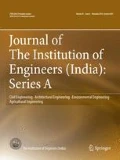Abstract
Hot mix asphalt (HMA) is a heterogeneous mix of aggregate, mineral filler, bitumen, additives and air voids. Researchers have indicated that the durability of the HMA is sensitive on the actual bitumen content and percentage air void. This paper aims at establishing the relationship between the bitumen content and the percentage air voids in Semi Dense Bituminous Concrete (SDBC) using Viscosity Grade-30 (VG-30) bitumen. Total 54 samples have been collected, for formulation and validation of relationship and observed that the percentage air voids increases with decrease in actual bitumen content and vice versa. A minor increase in percentage air voids beyond practice of designed air voids in Marshall Method of design is required for better performance, indicating a need for reducing the codal provision of minimum bitumen content for SDBC as specified in Specification for Road & Bridges (Fourth Revision) published by Indian Road Congress, 2001. The study shows a possibility of reducing designed minimum bitumen content from codal provision for SDBC by 0.2% of weight with VG-30 grade of Bitumen.

Similar content being viewed by others
References
L. Alex, A. Mehdi, S. Sahil, O. John, Sensitivity analysis of the life cycle environmental performance of asphalt and concrete pavement, in Concrete Sustainability Conference (2010)
S. Kim, H. Ceylan, K. Gopalkrishnan, Effect of M-E design guide input parameters on flexible pavement performance predictions. Road Mater. Pavement Des. 8(3), 375–397 (2007)
Indian Road Congress:37, Tentative Guidelines for the Design of Flexible Pavements, December, New Delhi, India (2012)
National Cooperative Highway Research Program, A Manual for Design of Hot Mix Asphalt with Commentary, NCHRP Report No. 673, Transport Research Board, Washington, United States (2011)
P. Krugler, M. Tahmoressi, D. Rand, Improving the precision of test methods used in VMA determination. Proc. Assoc. Asph. Paving Technol. 61, 272–303 (1992)
Indian Road Congress, Specification for Road & Bridges Works (Fifth Revision), on behalf of Ministry of Road Transport & Highways, Government of India, New Delhi, India (2013)
J. Goode, L. Lufsey, Voids, permeability, film thickness versus asphalt hardening, in Proceedings of the Association of Asphalt Paving Technology (1965), pp. 430–463
A. Kumar, Effects of Film Thickness, Voids and Permeability on Asphalt Hardening in Asphalt Mixtures, Technical Reports, through Joint Transportation Research Program, Purdue University, Indiana, United States (1976)
F.L. Roberts, P.S. Kandhal, E.R. Brown, D.Y. Lee, T.W. Kennedy, Hot mix asphalt materials, mixture design, and construction (National Asphalt Paving Association Education Foundation, Lanham, MD, 1996)
K.A. Willoughby, J.S. Uhlmeyer, J.P. Mahoney, K.W. Anderson, L.M. Pierce, Construction-Related Variability in Pavement Mat Density due to Temperature Differentials. Transportation Research Record No. 1849, Transportation Research Board, National Research Council, National Academies, Washington (2003), pp. 166–173
E.K. Kamil, W.W. Matthew, W.S. Bevan, Simple performance test for permanent deformation evalution of asphalt mixtures, in 6th RILEM Symposium PTEBM’03, Zurich (2003), pp. 498–505
D.W. Christensen Jr., R.F. Bonaquist, Volumetric Requirements for Superpave Mix Design, NCHRP Report No. 567, Transport Research Board, Washington, United States (2006)
F.M. Nejad, M. Mirzahosseeini, M.K. Novin, H. Abedi, The effects of bitumen percentage and percentage of air void on rutting potential of HMA by using dynamic creep test, in Proceeding of the LJMU 10th Annual International Conference on “Sustainable Construction Material & Pavement Engineering” 16th–17th Feb, Liverpool, UK (2011)
M.A.G. El Sayed, Effect of changing theoretical maximum specific gravity on asphalt mixture design. Eng. J. 16(4), 137–148 (2012)
D.B. Joshi, A.K. Patel, Optimum bitumen content by marshall mix design for DBM. J. Inf. Knowl. Res. Civil Eng. 2(2), 104–108 (2013)
N. Roy, A. Veeraragavan, J. Murali Krishnan, Influence of air voids of hot mix asphalt on rutting within the framework of mechanistic-empirical pavement design. Procedia Soc. Behav. Sci. 104, 99–108 (2013)
D. Baskandi, Influence of construction parameters on performance of dense graded bituminous mixes. IOSR J. Mech. Civil Eng. 12(1), 64–78 (2015)
V.D. Eshan, E.H. Chelsa, H. Benjamin, D. Jay, M.H. Chelsa, Laboratory Performance Test for Asphalt Concrete, Minnesota Department of Transportation Research Services & Library, June, 2015
H. Gerald, H. John, W. Jason, K. Anthony, H. Ali, Adjusting design air void levels in superpave mixtures to enhance durability, in 6th Eurasphalt & Eurobitume Congress, 1–3 June, Prague, Czech Republic (2016)
N.A. Hasan, M.Z.F. Mahmud, N. Adi, N. Rahmat, M.R. Hainin, R.P. Jaya, Effects of air voids content on the performance of porous asphalt mixtures. ARPN J. Eng. Appl. Sci. 11(20), 11884–11887 (2016)
Indian Road Congress, Specification for Road & Bridges Works (Fourth Revision), on Behalf of Ministry of Road Transport & Highways, Government of India, New Delhi, India (2001)
Author information
Authors and Affiliations
Corresponding author
Rights and permissions
About this article
Cite this article
Panda, R.P., Das, S.S. & Sahoo, P.K. Relation Between Bitumen Content and Percentage Air Voids in Semi Dense Bituminous Concrete. J. Inst. Eng. India Ser. A 99, 327–332 (2018). https://doi.org/10.1007/s40030-018-0282-y
Received:
Accepted:
Published:
Issue Date:
DOI: https://doi.org/10.1007/s40030-018-0282-y




